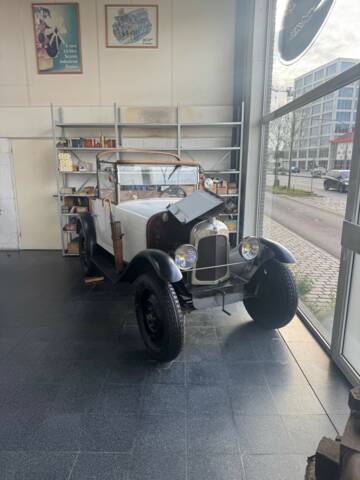Citroën 5 CV classic cars for sale
The Citroën 5 CV, produced from 1922 to 1926 and affectionately known as the 'Citron' for its distinctive yellow paintwork, is one of the most recognisable French cars of the early 1920s. With variants like the Type C, C2, C3, and the iconic 'Trèfle', the 5 CV stands out thanks to its innovative construction for its time, lightweight design, and characteristic single-door body. With strong supply and demand, it represents a unique piece of Citroën history.
Search results

History of the Citroën 5 CV
Launched at the Paris Motor Show in 1921 and appearing on the market in 1922, the Citroën 5 CV was conceptualised by André Citroën as a car tailored not just to technical requirements, but with a clear idea of its target audience. Advertised specifically for female drivers, this compact car was revolutionary for both its marketing and its engineering. The initial Type C version featured a single passenger-side door, a spare wheel on the left, and was exclusively available as a two-seater torpedo. Shortly into its production, the range was expanded to include a cabriolet variant. The car's memorable yellow became a hallmark, earning it the nickname 'Citron' (lemon in French). Citroën made car ownership more accessible by offering credit through a consumer finance company, an unusual move in the 1920s.
Model History: 5 CV, Type C1, C2, C3, and Trèfle
The 5 CV family began with the Type C1, equipped with an 856 cm³ four-cylinder engine and a 3-speed gearbox. The C1 was replaced by the C2 in 1923, which saw mechanical improvements, particularly in the ignition and chassis. The C3 followed in 1924, introducing rear suspension enhancements for greater driving comfort. Perhaps the most coveted version is the 'Trèfle', distinguished by its three-seat layout, with a unique rear single seat often referred to as 'the mother-in-law seat'. The 5 CV line concluded abruptly in 1926 as Citroën shifted focus to new models for the international market.
Highlights and Statistics of the Citroën 5 CV
The 5 CV is notable for its lightweight, approachable design tailored for new drivers in the 1920s. Its single-door, torpedo body and bright yellow finish set it apart visually. Technical innovations included a dry single-plate clutch and three-speed transmission. The Trèfle version, with its quirky three-seat arrangement, has a particular cultural cachet among collectors.
Technical Data
Special Editions and Collectible Models
The standout special model in the series is the 'Trèfle' (Type C3), notable for its three-seat configuration. This unusual arrangement—with two seats up front and a central rear seat—gives it a distinctive profile and has made surviving examples especially sought-after among enthusiasts of early Citroën innovations.
Weak Spots and Common Issues
Owning a 5 CV requires attention to period-specific issues such as wear in the mechanical drum brake system, possible weak points in the ignition, and corrosion in chassis and body joints—particularly important for open-bodied cabriolets. Owners should also check for replaced or mismatched parts, as period upgrades using pieces from models like the Citroën C4 were common.
Engine and Performance, Transmission and Handling
The 856 cm³ engine delivers moderate output, propelling the car to a maximum speed of around 60 km/h—a respectable figure for its time. The 3-speed manual box complements the engine's modest power, and the rear-wheel-drive chassis with leaf springs ensures a basic but solid ride. The later C3’s improved rear suspension offers slightly better comfort, especially for the rear seat passenger in the Trèfle. The Type C1 and cabriolet variants offer classic open-top driving reminiscent of interwar Europe, while the Trèfle’s seating layout provides a unique focal point for gatherings and events focused on historic motoring.
Interior, Comfort, Exterior and Design
Renowned for its cheerful visual presentation, the 5 CV's most memorable design feature is its bright yellow paint. The one-door layout gave it a distinctive side profile, with period accessories such as windscreens, covers, and trim often replaced or upgraded—including with later Citroën C4 parts. The simple interior with minimal instrumentation, period-correct materials, and basic seating offers an authentic 1920s motoring experience. Cabriolet variants bring the possibility of open-air drives, while the Trèfle configuration is instantly recognisable for its seating arrangement.
Other Noteworthy Features
Due to the car's age, many existing examples may have bespoke elements or period modifications; it’s common for windscreen frames and covers to be taken from other Citroën models. The practice of 'updating' bodies with more modern panels was typical through the 1930s, influencing the individuality of today’s restored 5 CVs.
Summary
A product of French innovation in the early 20th century, the Citroën 5 CV stands today as a testament to clever engineering and creative design. Its market presence is largely defined by a combination of unique technical solutions, vibrant design, and a direct connection to Citroën’s pioneering years. Whether in standard, cabriolet, or Trèfle form, the 5 CV embodies a slice of motoring history tailored for enthusiasts interested in authentic, early-classic continental vehicles.
